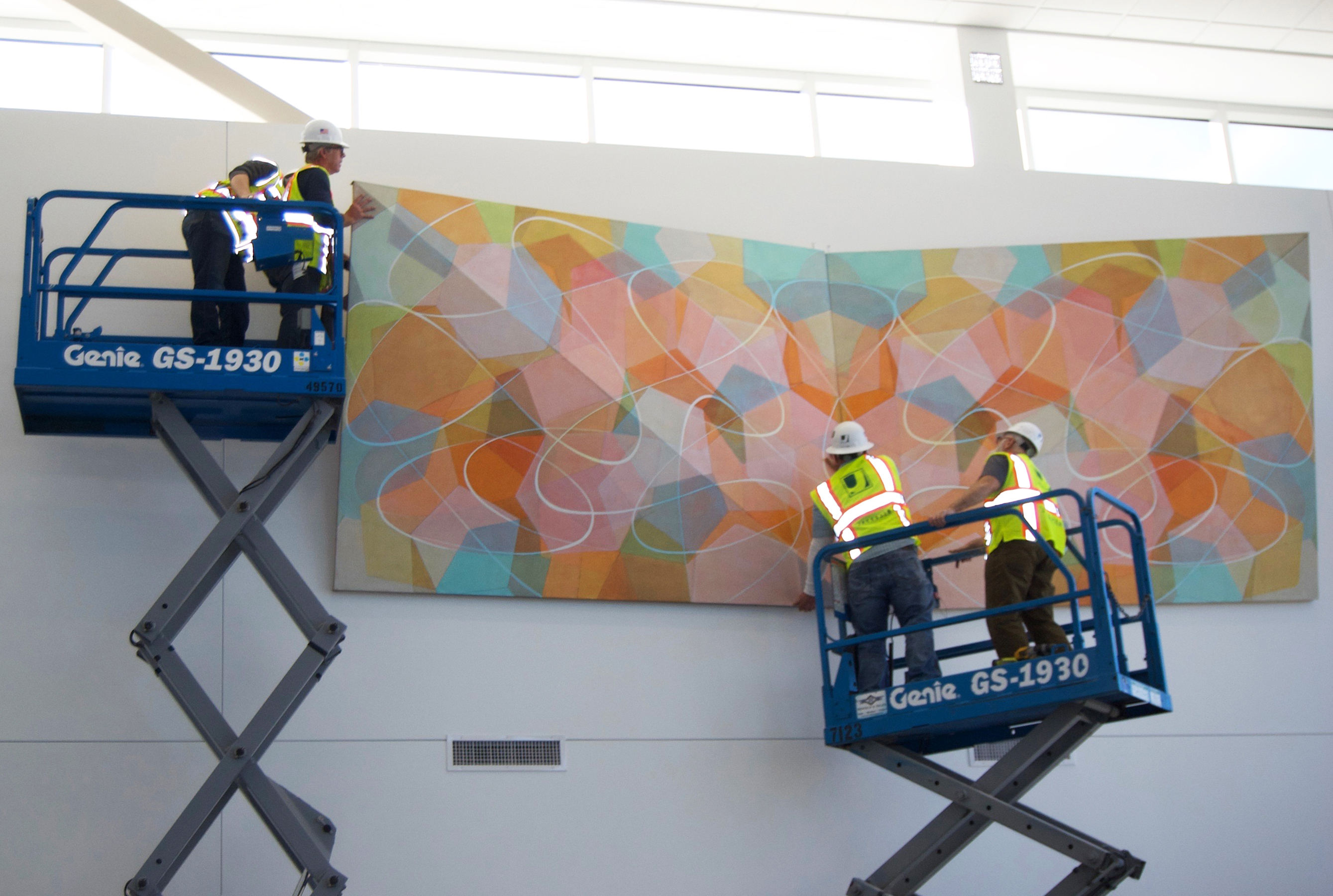ASU professor draws on scientific themes for artwork at new biology building in Utah

When a new building dedicated to teaching life sciences opens in January at Utah State University, it will feature a soaring, vibrantly colored artwork by an Arizona State University professor who used the principles of biology to create it.
Mark Pomilio, an associate professor in the School of Art in the Herberger Institute for Design and the Arts, spent the past year working on “Symbols and Symmetries,” which was recently installed in the third-floor atrium of the building.
“There was a specific context for the piece from the get-go — the type of research, like biology and genetics, that is going to be happening in this space,” he said.
“The design idea was to create it almost like an organism with that kind of interaction between the parts and the whole, and it made perfect sense with the way I create my pieces.”
Pomilio started the three-dimensional work by thinking about scientific imagery and began playing around with a hexagon. The six-sided shape shows up everywhere in nature, from honeycombs to the molecular skeletons.
The artwork "Symbols and Symmetries" by Mark Pomilio was recently installed in the new Life Sciences Building at Utah State University.
As he worked, the shapes built on each other.
“One doesn’t exist on its own,” he said. “Each is always in relation to the previous one, just like something would grow in nature.”
Technically, the work was a challenge. Initially meant to be two smaller pieces, the project was altered halfway through to become one large work. Pomilio had to rent studio space because his own studio wasn’t large enough to accommodate the 8-by-20-foot piece.
“I had to take it off the stretcher bars and roll it up to take it there,” he said. “The linen had to be prepared in a certain way to remain flexible and the paint had to be used in a certain way so it would stay flexible.”
Last month, Pomilio put the disassembled work into a truck and drove 12 hours to the Utah State campus in Logan, Utah, where he reassembled it and installed it in the 103,000-square-foot Life Sciences Building. The colors in “Symbols and Symmetries” reflect the shades of red in the mountains seen through the wall of windows.
Creating large-scale art is nothing new for Pomilio, who taught a course in public art at the University of Michigan and created seven pieces on the campus there.
The metro Phoenix area is nationally known for its vibrant public art, according to Betsy Fahlman, a professor of art history in the School of Art at ASU. She noted that the illuminated piece at the Civic Space Park next to the Downtown Phoenix campus, “Her Secret is Patience,” was funded by the City of Phoenix Arts and Culture Commission. (“Her Secret is Patience” is by Janet Echelman, with lighting by Paul Deeb.)
“Public art can be a memorial, it can highlight a neighborhood, and it gives a place interest,” said Fahlman, who also is adjunct curator of American art at the Phoenix Art Museum and a former board member of Scottsdale Public Art.
“Public art enlivens the environment. It’s fun to come upon a piece and be surprised,” she said.
The work is near a wall of windows that showcases the nearby mountains in Logan, Utah.
“It makes the place have texture.”
Fahlman spent years involved in the process of taking public art from proposal, through many conversations and approvals with stakeholders to the final unveiling. It can be a fraught undertaking as everyone weighs in and all the factors are considered, she said.
“Public art has to be ADA compliant, you need to make sure it’s safe, you have to make sure someone won’t climb on it. Is it going to offend anyone?” she said.
“Public art has a lot of supervision.”
Pomilio went through an extensive application process for the Utah project, including giving a presentation to a panel of architects, designers, deans and faculty. He won the bid over more than 300 applicants.
“I think they understood that I would make a piece that was in line with what they wanted,” he said. “But I wouldn’t know exactly what it was going to be until I got deeper involved in the project.
“They had to take a leap of faith in the outcome.”
Top image: Mark Pomilio (left) and his friend, artist Glenn Downing, stretch the linen-backed painting over the wood substrate before installing it in the building at Utah State University. Photo by Mary-Ann Muffoletto/Utah State University
More Arts, humanities and education

Grand Canyon National Park superintendent visits ASU, shares about efforts to welcome Indigenous voices back into the park
There are 11 tribes who have historic connections to the land and resources in the Grand Canyon National Park. Sadly, when the park was created, many were forced from those lands, sometimes at…
ASU film professor part of 'Cyberpunk' exhibit at Academy Museum in LA
Arizona State University filmmaker Alex Rivera sees cyberpunk as a perfect vehicle to represent the Latino experience.Cyberpunk is a subgenre of science fiction that explores the intersection of…

Honoring innovative practices, impact in the field of American Indian studies
American Indian Studies at Arizona State University will host a panel event to celebrate the release of “From the Skin,” a collection over three years in the making centering stories, theories and…

